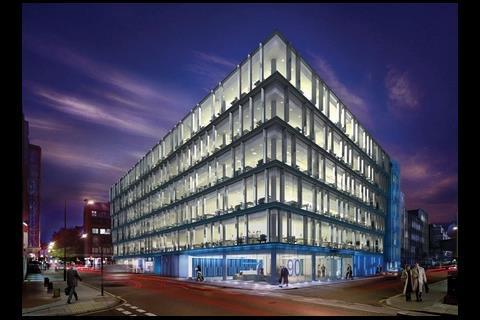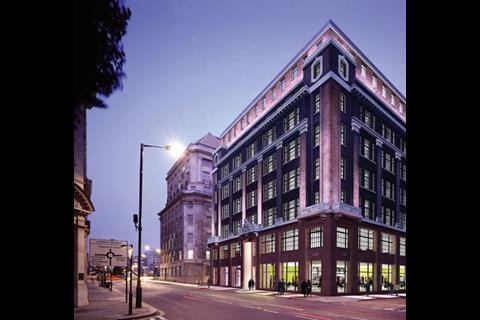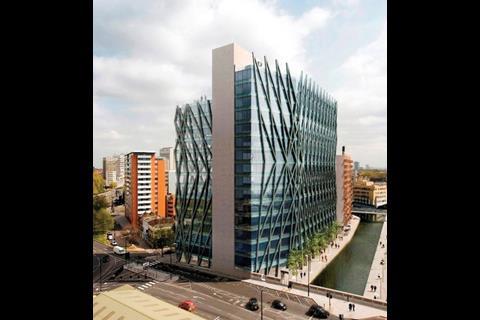Derwent LondonŌĆÖs Simon Silver likes to champion exciting young architects. And now that the developer has doubled its portfolio, he can offer them bigger commissions than ever before. Just get a little sartorial advice before you make your pitch.
Architects, prepare to fall in love.
ŌĆ£At the end of the day,ŌĆØ says Simon Silver, head of development at Derwent London, ŌĆ£our buildings are only as good as the architects that work on them. For me, this is the exciting side of the business ŌĆō an architect bringing in his first thoughts on how he sees a scheme evolving.ŌĆØ
Not only does Silver nurture an old-fashioned respect for the profession, he is also prepared to spend money on it: ŌĆ£Rather than save a few bob, we want something really good. We prefer to spend a bit more.ŌĆØ
And get this: he hates design-and-build contracts. ŌĆ£It takes away too much from our architects. We want the architect to remain in control,ŌĆØ he says.
He has been an architectsŌĆÖ favourite since 1984, when he joined newly formed developer Derwent Valley. In February, the company merged with London Merchant Securities to form Derwent London, BritainŌĆÖs sixth-largest property firm with a portfolio of ┬Ż2.5bn. It converted to real estate investment trust status in July.
Silver reckons he sees ŌĆ£a few dozenŌĆØ new practices every year, and his dedication to design was recognised in 2005, when the RIBA awarded him an honorary fellowship for championing young practices. In fact, Silver is a bit like an architect himself, even down to the black square-framed specs. His minimalist office is filled with coffee-table books on architecture and arty black-and-white photos. ŌĆ£IŌĆÖve always liked good design. It can be clothes, it can be a car ŌĆō I just like nice things.ŌĆØ
The obsession with architecture began on one of Derwent ValleyŌĆÖs first projects ŌĆō a warehouse refurbishment in Islington. ŌĆ£It was a bit out of the blue actually. We asked this very young firm of architects to look at the building: John McAslan and Jamie Troughton. TheyŌĆÖd just left Richard Rogers and when we met them, we were smitten. We liked everything about it, visiting their offices and what you can do to buildings. We realised there was a lot to be gained from going for really hungry, innovative architects.ŌĆØ
Silver is a small, energetic man. He speaks quickly, barely stopping for breath, racing off for minutes at a time in response to questions. One of his architect fans describes him as a ŌĆ£little guy with a big personalityŌĆØ; everyone agrees heŌĆÖs ŌĆ£a really nice guyŌĆØ. One of his most frequently used words is ŌĆ£excitingŌĆØ.
Derwent Valley built up a reputation for spotting the potential in unusual buildings in fringe areas of London and turning them into des res for trendy media firms. Its trademarks are high-spec minimalism and quality architecture. The developerŌĆÖs buildings do have a certain look. As Silver says, ŌĆ£We donŌĆÖt like fussy architecture, we like clean lines and volume and light.ŌĆØ
The deal with London Merchant has brought it a selection of buildings that Silver says it would never have the chance to buy on the open market, such as the Angel Centre in Islington, though it will sell off ┬Ż300m-400m worth of non-core assets outside the capital. Derwent London will focus on 13 ŌĆ£villagesŌĆØ in central London, in particular Fitzrovia, Paddington, Embankment and Southwark.
This will be an advantage if the central London lettings market takes a long-term hit from the stock market turmoil, says Silver.
ŌĆ£We will be delivering really good schemes ŌĆō basically on the edge of the West End ŌĆō that will be affordable to those companies who donŌĆÖt want to pay ┬Ż100/ft2 and where quality of design and architecture is an attraction.ŌĆØ
Derwent LondonŌĆÖs doubled portfolio will allow it to focus on what Silver calls ŌĆ£super-sitesŌĆØ in the future ŌĆō nothing below 40,000ft2. He is most excited about a scheme at North Wharf Road, facing the main rail terminal in Paddington. ItŌĆÖs a massive site, masterminded by Fletcher Priest, that will comprise 250,000ft2 of offices and two residential buildings, on either side of the canal, with new public space in between.
Silver and Paul Williams, DerwentŌĆÖs property management director, have a big happy family approach to building teams. Silver recruits the architect, Williams the QS and contractor. The firms they keep going back to include architects AHMM, Fletcher Priest, Lifschutz Davidson Sandilands and Squire and Partners, QSs Jackson Coles and Davis Langdon and contractor ISG. ŌĆ£If someone does something good, why would you not use them again?ŌĆØ says Silver.
This makes it hard to give work to every up-and-coming practice, but he finds time to meet new firms anyway. ŌĆ£Some of them leave a lasting impression and you think, given an opportunity, IŌĆÖd really like to work with them. But you donŌĆÖt always get that opportunity. Although weŌĆÖre a big company, projects have grown in size and youŌĆÖre trusting people with 100,000ft2. YouŌĆÖve got to be pretty sure of who they are and what they do.ŌĆØ
He often gets referrals from established practices to see young firms and he always takes them up ŌĆō many of the larger firms Derwent London works with today were six or seven-strong when the relationship began.
ŌĆ£With young firms you get young ideas and good ideas. ItŌĆÖs nice to see the different ideas people create because youŌĆÖve got to always move forward, we want to be ever-evolving and create the next exciting scheme and not just a repeat of something weŌĆÖve done. Because there are imitators out there.ŌĆØ
To get through the door, your portfolio has to fit. ŌĆ£ThereŌĆÖs a certain style of architecture weŌĆÖre looking for and you can normally read it in peopleŌĆÖs work.ŌĆØ
So what impresses him? ŌĆ£Certain people have an energy about them that is attractive or not; I think itŌĆÖs all about their vision and architectural style. And, you know, someone might come in wearing polka dot socks that I donŌĆÖt like and I think, oh dear, but they might produce brilliant buildings.ŌĆØ
ŌĆ£Oh!ŌĆØ he interrupts my next question, ŌĆ£IŌĆÖve left out one very big thing ŌĆō gotta have a sense of humour. You canŌĆÖt be working on a project for three years without people who make you laugh. ThereŌĆÖs a spark or an energy you like about people, itŌĆÖs personalities as well as their talent. The team is the be all and end all; you need to know that youŌĆÖre going to get on and that thereŌĆÖs good chemistry.ŌĆØ
The most exciting thing heŌĆÖs seen lately was in the offices of a much larger practice.
ŌĆ£I was round Richard RogersŌĆÖ office, and I saw a model of the Cheese Grater [the Leadenhall building] in the City. That, I think, is going to herald a new era of office building and I thought it was fantastic.
ŌĆ£I know the fashion is to put a skyscraper up, but itŌĆÖs not my personal niche. If there was the opportunity for Derwent to build one, weŌĆÖd look at it but IŌĆÖm not a fan of the skyscraper for London. When I go to the top of a tall building I find it all a bit anonymous.
ŌĆ£But great architects produce great buildings whether theyŌĆÖre small or large. I got very excited at RogersŌĆÖ office ŌĆō thatŌĆÖs the sort of architecture that excites me.ŌĆØ
Simon SilverŌĆÖs design classics
Barcelona Pavilion by Mies van der Rohe
Andy Warhol loafers by Berluti shoes
Avanti Studebaker car by Raymond Loewy
Pirellone floor lamp by Gio Ponti and produced by Fontana Arte
PK22 chair by Poul Kjaerholm
His best building Maison de Verre in Paris, designed by Pierre Chareau
His worst building Visage, an apartment block in Swiss Cottage, London. ŌĆ£It completely spoils the views when walking through Primrose Hill ParkŌĆØ
Coming soon from Derwent ŌĆ”
Qube, Tottenham Court Road, W1, ┬Ż26m
Construction is almost complete. 100,000ft2 of offices will come to the market next month.
Architect, QS, contractor: EPR, Cyril Sweett, Laing OŌĆÖRourke
Portobello Dock, W10, ┬Ż8.95m
The old EMI/Virgin headquarters is being turned into 65,000ft2 of offices and 19 flats. The project is made up of six buildings. Now on site, it is due for completion in December.
Stiff + Trevillion, David Langdon, Jackson Coles, Tolent, Knight Harwood
16-19 Gresse Street, W1, ┬Ż21m
Part of Derwent LondonŌĆÖs plan to take over swaths of Fitzrovia. In development at the moment, it will comprise 47,000ft2 of office space. It is due for completion in July 2009.
Lifschutz Davidson Sandilands, Jackson Coles, Balfour Beatty
Horseferry House, SW1, ┬Ż18m
Now on site, the building will total 163,000ft2 of offices when completed in April 2008. It will be the HQ of luxury brand Burberry.
AHMM, Jackson Coles, ISG Interiors
North Wharf Road, W2
A massive site just opposite the main Paddington terminal comprising 250,000ft2 of offices and 100,00ft2 of residential space in two buildings. It is in for planning right now.
Fletcher Priest, Davis Langdon
Wedge House, SE1, ┬Ż28m
This Southwark scheme goes on site at the end of next year and will contain 39,000ft2 of offices. It is set for completion in 2010.
Lifschutz Davidson Sandilands, Davis Langdon
ŌĆ” and one thatŌĆÖs open
Johnson building, EC1, ┬Ż27m
A redeveloped 1930s office by AHMM. Let to an advertising agency and Faber Maunsell






























No comments yet